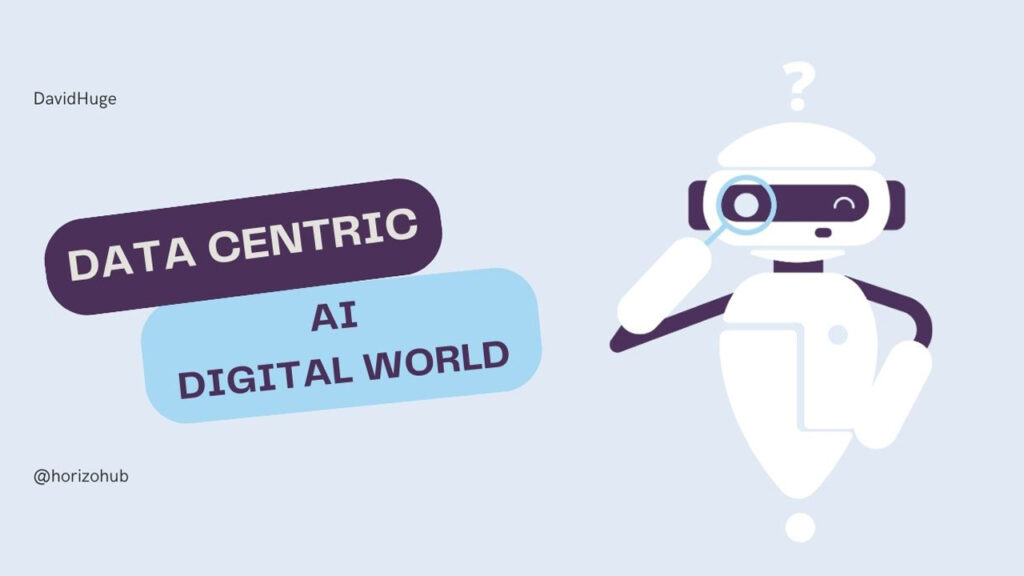Introduction
AI is at the center of the current revolution that is sweeping enterprises and industries. Nonetheless, while traditional AI systems have been developed in many domains, they are mostly application-centric and not data-oriented. Data-Centric AI is a new trend that aims to make data more central to the strategy of companies and their value creation process.
What is Data-Centric AI?
Using artificial intelligence systems in business is now seen as a necessity rather than an option. However, for data-centric AI to steer the change to the right direction in the digital context, a more strategic approach is required – and that is the essence of this paper.
DCAA focuses on the use of data and analytics to support business decision-making and organizational management.
It entails:
- Assembling a single and unified data repository from every single business segment and outside source.
- To analyses the data, often applying methods such as analytics, machine learning or artificial intelligence.
- It focuses on providing the means of allowing data to flow freely within and between the various organizations.
- Making decision and actions to be preformed automatically by using intelligent inputs.
According to our point of view, data-centric AI can expand the sphere of its application in modern organizations and become the unique development that will provide a tool to improve the decision-making, reconsider the business processes, and create new values with the help of data.
The aim is to achieve operational data integration, broad distribution of information, and the creation of an intelligent central hub to improve all processes and transactions.
Why data centrism matters now?
There are several key reasons why data-centric AI is especially relevant today:
- The size and types of data that are available have grown to be big and diverse, both in structural form and in other forms. This information constitutes the “big data,” the vast quantity of which, when properly analyzed, can be of immense worth.
- This is because organizations in various industries are demanding efficient and accurate data analysis in an earlier time. Data-centric AI can quickly go through large statistical sets.
- There is one more factor – the need to introduce AI/ML data analytics as a means to enhance competitiveness. Those that do not adapt will become obsolete, and hence, this is one of the key factors that make the concept crucial to implement.
Key Benefits of Data-Centric AI
Adopting a data-centric approach to AI delivers manifold benefits, including:
- Better decision making: High quality data and better systems to organize information can lead to significantly better decisions in terms of strategic, as well as tactical choices.
- Increased efficiency: One of the benefits of using technology is that information can be used to automate activities and procedures. For instance, a recent research had it that companies that implement data-driven approaches spend half the time on the routine data processes.
- Enhanced customer experiences: Sophisticated data collection, customer segmentation, and use of big-data analytics enable creating highly targeted business experiences and contacts.
- New revenue opportunities: Even more importantly, the flow of data and insights across departments and partners is crucial for generating new product, services, and business models beyond the reach of a single department or organization.
- Future-proofing: It is vital for organizations to adopt data-centric processes because it enables them to adapt to growing AI technologies.
- Objective: Working with data instead of knowledge and personal experience, which is an important key to change for many organizations.
- Identify inefficiencies: That is why process data are analyzed to identify inefficiencies in the processes so that process improvement can be carried out.
- Personalized information: Optimizing the value customers derive from personalized information assembled from their own and others’ purchase behaviors.
- Customer data: This involves providing faster time to market for new products in relation to analysis of customer data.
Gartner’s projection for 2023 highlights that data centric AI is expected to be the primary driver of AI adoption by more than fifty percent of organizations.
Use Cases Across Industries
Data-centric AI has valuable applications across sectors:
- Retail – this involves the use of the Company’s sales data, web traffic, and inventory levels for forecasting demand, as well as for the purpose of adopting the most appropriate prices.
- Business and Finance - It can be used to quickly identify fraudulent transactions, enhance the trading approaches for the stocks, and enhance the portfolio management by evaluating the appetite for risk.
- Health care – Performs scans and data analysis for diagnosis and predict the possibility of the patient’s readmission into the hospital.
Real-World Applications and Examples
Here are some examples of data-centric AI delivering value:
- Personalized recommendations: Stores including Amazon have long used customer information to determine their habits in order to make suggestions that will prompt more purchases. Solutions contribute 20% to Amazon’s gross sales while recommendations account for 35%.
- Predictive maintenance: Siemens and other industrial firms gather and analyze data from the sensors of equipment to detect a problem before a system failure, thus reducing on the time that the equipment is out of action.
- Fraud detection: Financial institutions use transaction information to train artificial intelligence systems for credit card fraud identification, reducing theft rates and preventing significant losses. Specifically, fraud artificial model of the JPMorgan Chase has the accuracy of 90 percent.
- Smart supply chains: Manufacturers like Unilever are using the reams of data from inventories, logistics and sales to fine-tune their manufacturing processes and reduce wastage. This has been able to catalyse a saving of €150 million annually for Unilever.
- Precision medicine: Through the clinical, genetic, and patient data, healthcare providers are able to prescribe treatments based on patient condition profile to enhance the treatment results for specific patient conditions.
The idea linking the above is leveraging of the intelligence derived from data to improve tactical and strategic decision-making across functioning.
Challenges in Adoption
Nonetheless, Gartner Inc. , a leading analyst firm, points out that about half of all AI initiatives stall at the pilot and proof-of-concept stage and do not progress to becoming production-scale deployments.
Challenges organizations face in adopting data-centric AI abound and include:
- Data silos and poor data quality: Even today, more than 60% of companies cannot collect data from different sources and integrate them into a single platform. To overcome this type of barrier, it requires policies that will guarantee funds for the improvement of data infrastructure and policies on how to govern the data.
- Lack of strategic vision: Most companies adopt AI strategically in the organization for particular purposes instead of employing it mechanistically through a unified data plan with regards to organizational objectives.
- Talent shortage: According to projections made for the future, the deficit of data and AI specialists can reach 3 million by 2025. In the future, organizations need to ensure investment in talent attraction, employee development and customization of skills.
- Bias and ethical issues: Current AI systems are merely an extension of human values and practices and can result in injustice, risk or undesired consequences if designed improperly. Preventing this means that insisting on responsible AI from the beginning is necessary.
- Privacy Concerns: Cumulating enormous amounts of customer data provoke regulations and public debates on data openness and permission. Companies require specific guidelines on who has the authority to input, update, and delete data.
The Next Frontier: AI-as-a-Service
The challenges involved in constructing, implementing as well as maintaining robust AI solutions at scale forces many enterprises to simply rely on SaaS based AI tools from cloud service providers such as AWS, Microsoft Azure or Google Cloud. The following are the vendors that selling pre-built AI services such as, computer vision, language, processing, predictions, recommendations and etc.
AI analysis or cognitive systems as a service worldwide will be at $50 billion by 2025 according to IDC. Due to the availability and accessibility of AIaaS, organizations that may not possess the necessary data science personnel to employ complex data analytic techniques can do so. It also facilitates quick iteration.
Nevertheless, the ability to assemble the required services into a set of ready applications for production remains a problem. However, such models cannot function on their own; companies must continue to develop their AI talent, oversight and the assimilation of cloud solutions into their business processes. Hence, while solutions such as AI-as-a-service contain one part of the equation, organizations require effective strategies to harness data-centric AI in the long run.
Implementation Challenges
While the potential of data-centric AI is compelling, there remain barriers to effective implementation:
- Specifically, the following barriers have been identified as hindering effective use of data: Data silos and weak data architecture.
- Skills deficit in AI and data science.
- Adoption issues arising when transitioning from a culture of reliance on intuition to one centered on data.
- Data bias and its implications for AI, including ethical conduct and governance structures.
The AI of Tomorrow
Because of the developments in data storage and computations, data-centric approaches to AI will become even more pervasive and valuable in organizations. This new paradigm is poised to offer the potential of higher levels of automation, better decision-making, and faster reinvention for competitive advantage. Finally, there are societal impacts that could be dramatic in relation to productivity, convenience, health, and overall quality of life. However, general principles of responsible governance and ethical practices concerning the personal data and algorithms will be still highly relevant.
Conclusion
AI based on data has the ability to revolutionize business processes on different levels and grant the organizations that embraced digital transformation a competitive advantage. But they need more than just ad-hoc AI applications in the enterprise. AI cannot evolve to its potential and reach its full potential unless companies encourage data culture, eliminate data walls, and implement strategic cross-functional initiatives. Like the Internet, AI is an enabler that with a competent leadership, talent investment, and collaboration with the cloud AI providers, the legacy enterprises can reinvent themselves into data-driven organizations.




